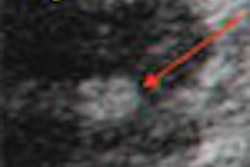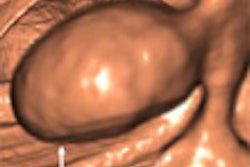Plans are afoot, one slow step at a time, to add virtual colonoscopy to the American College of Radiology's list of accredited procedures. Accreditation -- an ACR stamp of approval that does double duty as the law of the land for mammography, and a standard operating procedure for several other imaging modalities -- is always a positive development in that it establishes practice standards and ensures that radiologists meet minimum compliance levels.
But is accreditation enough? It is certainly no panacea, and by itself cannot ensure consistent performance in any modality, according to Dr. C. Daniel Johnson, professor of radiology at the Mayo Clinic in Rochester, MN. If virtual colonoscopy is to translate accreditation into better performance, best practices rather than simply reasonable ones will need to be put in place, Johnson said in October at the 5th International Symposium on Virtual Colonoscopy in Boston.
"The rationale for all accreditation programs sponsored by the (American College of Radiology) began in 1960s as a response to increased government interest in accreditation programs," Johnson said. "The ACR felt like it was better to have experts come together and have our own standards than have the government impose them on us."
Come together they did. In the post-LBJ era, radiologists' efforts have produced accreditation programs for radiation oncology (1987), ultrasound (1995), stereotactic breast biopsy (1996), MRI (1996), breast ultrasound (1998), nuclear medicine (1999), CT (2002), and radiography/fluoroscopy (2002), according to the ACR's Web site.
The organization's three-step accreditation process, or triumvirate as the Reston, VA-based ACR calls it, consists of standards to define procedural performance, the submission of documents and standards, and appropriateness criteria to define when and on whom the procedure should be applied, Johnson said.
Standards are the cornerstone of accreditation. They include the detailed responsibilities of personnel performing the procedure, exam specifications, documentation, appropriate equipment, and quality-improvement mechanisms, he said.
The preliminary VC reporting standards, presented at the same meeting by Dr. Michael Zalis from Massachusetts General Hospital in Boston, for example, are a component of the standards being assembled by the ACR's colon cancer committee.
Are standards enough?
Still, the effectiveness of the standards is limited by their voluntary nature, Johnson said, and there are too many inherent weaknesses to ensure quality performance.
The standards "really define reasonable practice, not best practice, and I think this is really the Achilles heel of a standards program -- because reasonable practice and best practice are sometimes miles apart," he said. "I think that the political reality of the ACR is that we try to be too inclusive by making the standards so loose that nearly everyone can qualify."
Even in mammography, still the only program to require accreditation as condition of imaging, there is little to suggest that accreditation equals consistent performance. In fact, a 1996 study from the Medical College of Wisconsin in Milwaukee found stubbornly high levels of performance variability among mammographers, Johnson said.
In that pre-CAD-era study, Beam and colleagues found that screening sensitivity varied by at least 40% among U.S. radiologists, the authors wrote. There was a range of 45% in the rate at which women without breast cancer were recommended for biopsy. Finally, an ROC curve showed that radiologists varied by as much as 11% in their ability to detect cancer in mammograms (Archives of Internal Medicine, January 1996, Vol. 156:2, pp. 209-213).
"Current accreditation programs that certify the technical quality of radiographic equipment and images but not the accuracy of the interpretation given to mammograms may not be sufficient to help mammography fully realize its potential to reduce breast cancer mortality," Beam et al concluded.
"We're trying to eliminate the really poor performers at one end of the bell curve," Johnson said. "We really need to be pushing everyone toward the excellence end of the quality spectrum."
A better way
Paying more attention to the care process may be one way to raise the performance bar. Take the standard model, in which a primary care physician orders the exam, a radiologist performs and interprets it, and reports the result to the primary physician. There are opportunities to monitor performance throughout this process, Johnson said.
"We can measure the appropriateness of the order protocol, the technical standards, the equipment, quality of personnel, how well the exam was interpreted, the timeliness of the report, and whether we really answered the referring physician's questions, as well as the global outcome," he said.
Best practices need to be defined at every level of care, resulting in standardized metrics, national benchmarks, and finally, accreditation of those processes to achieve consistent results. Current ACR standards are inadequate because they are limited to technical aspects of the exam, leaving half of the patient care process unexamined. The time to start developing more comprehensive metrics is now, Johnson said.
"It's somewhat like doing flexible sigmoidoscopy -- we're only examining half of the colon here, and we're really only evaluating half of the patient care process with our current standards and accreditation," Johnson said. "We need to be very careful before we take a step in an accreditation process that's along the lines of what we already have, because I think there's a trap where we're going to lower ourselves into complacency, and (VC) could go the same way as the barium enema," he said. "We need to make a change so that this never happens again."
By Eric Barnes
AuntMinnie.com staff writer
February 16, 2005
Related Reading
VC gets long-awaited reporting standards, November 2, 2004
Ultrasound accreditation pays off, August 19, 2004
ACR reverses course on ortho MRI, May 11, 2004
Rhode Island rings in New Year with MRI accreditation law, January 1, 2000
Copyright © 2005 AuntMinnie.com



















